Requirements for the meter location
NSVA is responsible for the water meter, and as a property owner, you are responsible for ensuring that your property has an approved meter location. Having an approved meter location is a prerequisite for NSVA to install and replace the water meter. It is also a safety measure for you as a property owner to have a secure meter location to minimize the risk of costly water leaks.
Clear space around the meter
From a workplace safety perspective, it should be easy to access the water meter. The meter must not be enclosed or placed behind heavy equipment or fixtures. A space of 60 cm in front of, 50 cm below, and 70 cm above the meter must be free from objects.
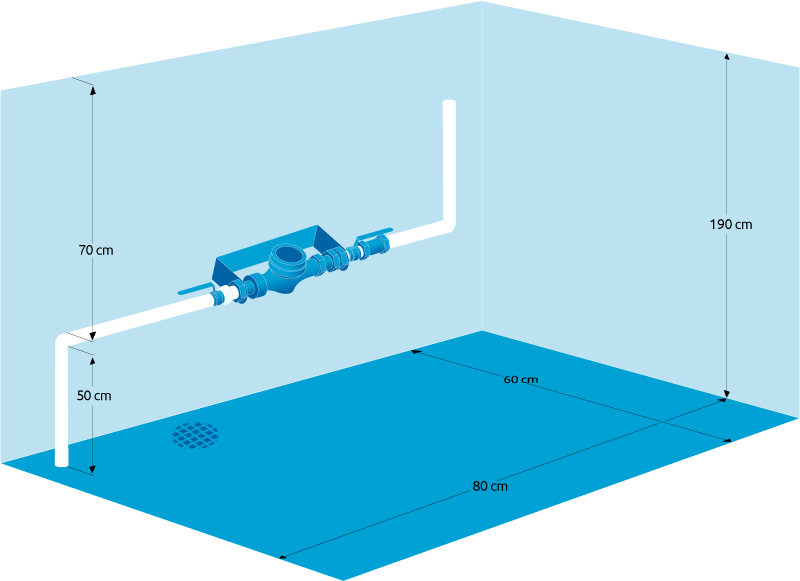
Protected location
The meter location should be in a heated space to protect the water meter from freezing. A frozen water meter can cost a lot of money and cause significant water damage. The water meter should also not be in a space where it is exposed to harmful heat. In addition to the requirements, we recommend having a floor drain and ensuring that the walls and floors around the meter location can withstand spills and water leakage. It is also good to have lighting at the meter location for easy reading and replacement of the meter.
Meter bracket and check valve
New connection/reconstruction of the meter location
For new connections and reconstructions of the meter location, the meter must be securely mounted in a bracket with shut-off valves before and after the meter. The bracket should be tailored to the meter size and have a sliding coupling sleeve. No piping may be installed within the bracket; the bracket is intended solely for the water meter. A fixed controllable check valve per meter must also be installed. The check valve should be placed after the outgoing shut-off valve.
Existing meter locations
For existing meter locations, it is not a requirement for the meter to be securely mounted in a bracket. However, we recommend having one installed afterwards. To install a bracket, you need to hire a plumbing company. The cost is covered by you as the property owner.
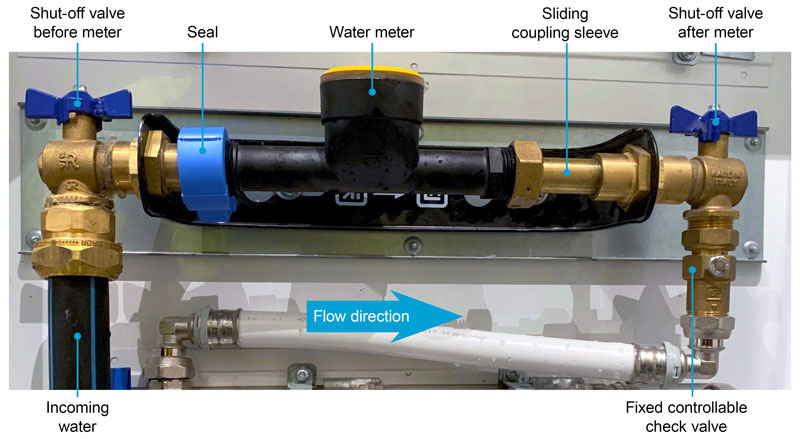
Functioning and approved shut-off valves
There should be manual shut-off valves for the incoming water, one before the water meter and one after the water meter. If there is a water leak in your property, you must be able to shut off the water. The water must also be shut off to carry out a meter replacement. Most insurance companies require you to have approved and functioning shut-off valves. If your shut-off valves are broken or missing, you need to contact a plumbing company for repairs.
Check that the shut-off valves are functioning
To ensure that the shut-off valves are functioning, you need to check them regularly and before a water meter replacement. See how to do it here: Check the valves.
Automatic shut-off valves
Automatic valves are valves that can be controlled with switches and apps or that automatically cut off the water if a water leak occurs. If you are installing an automatic shut-off valve, it should be installed after the manual valve after the water meter. Having only an automatic shut-off valve after the water meter is not approved for safety reasons.
Non-approved manual shut-off valves
If you have shut-off valves for your incoming water called LK580, LK581, or LK582, you must replace them. They are no longer approved due to the risk that the valve handle will detach from its mount, posing a risk of both personal injury and significant water damage. NSVA does not carry out meter replacements on facilities with these shut-off valves, and the facility will be rejected during inspections.
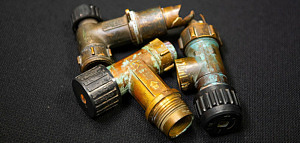
Check valve
There should be a controllable check valve installed at your water meter. Drinking water is classified as food and is subject to food legislation. The check valve prevents contaminated water from flowing back into the municipal drinking water network.
New connection
For new connections, a controllable check valve must be installed by the property owner.
Existing facilities
For existing facilities, NSVA installs a check valve in your water meter when the water meter is replaced.
Businesses
Higher requirements may be imposed on businesses. Your municipality/NSVA determines which type of backflow prevention device should be installed based on standard SS-EN 1717. The property owner covers the cost of the backflow prevention device.
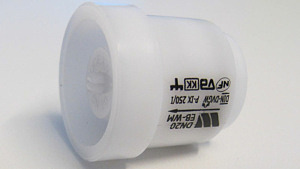
Safe installation
Earth clamps from electrical installations must not be mounted on the coupling sleeves. If they are, there is a high risk of someone getting an electric shock while working at the meter location. The pipes to and from the meter must not be corroded. If they are, there is a risk of leakage. The pipe at the meter must be clamped. If it is not, there is a risk of it breaking when the meter is removed from the pipe, for example, during a meter replacement.
Water meter in meter pit
Sometimes the water meter cannot be installed inside the property and is instead installed in a meter pit. The meter pit is considered a meter location and is the responsibility of the property owner. The same requirements apply as for a meter location indoors. As a property owner, you are also responsible for ensuring that the meter pit has a lid that is easy to lift, that there is a ladder to climb down on, that the meter pit is easily accessible and cleared of stones, bushes, and debris, and that the pit is clearly marked with a sign. We recommend installing a water meter bracket with a so-called flexi-coupling.
Meter reading
NSVA offers reading of water meters that are installed in a meter pit for a fee according to the current water tariff.
Pumping
NSVA offers pumping of the pit for a fee according to the current water tariff.
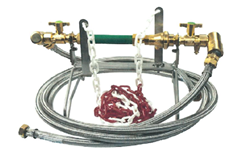
Sealing
When NSVA installs a water meter, a seal is attached to the incoming side of the meter. This must not be removed.